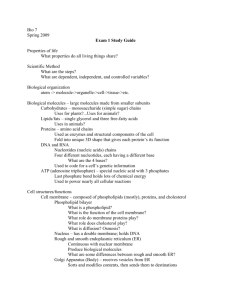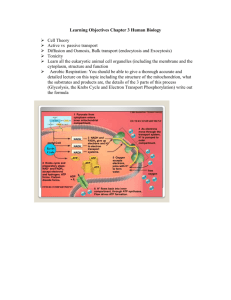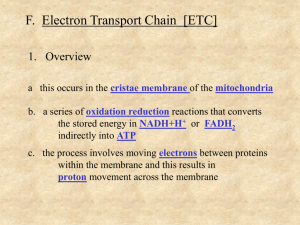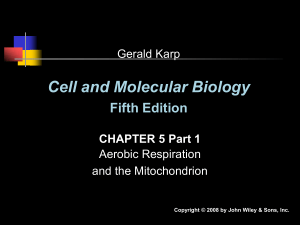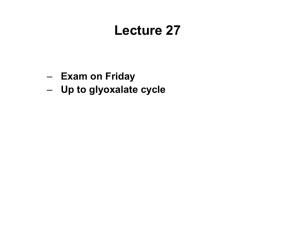Cell respiration balance sheet overview powerpoints2
advertisement
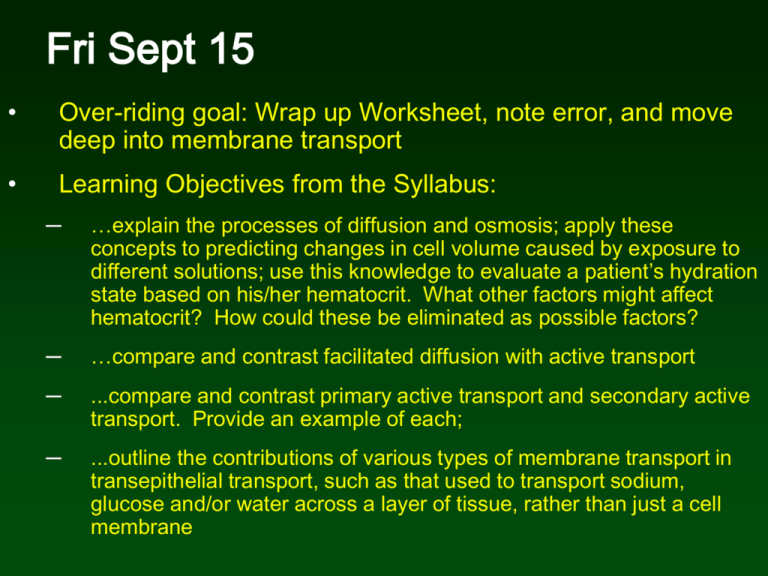
Fri Sept 15 • Over-riding goal: Wrap up Worksheet, note error, and move deep into membrane transport • Learning Objectives from the Syllabus: ─ …explain the processes of diffusion and osmosis; apply these concepts to predicting changes in cell volume caused by exposure to different solutions; use this knowledge to evaluate a patient’s hydration state based on his/her hematocrit. What other factors might affect hematocrit? How could these be eliminated as possible factors? ─ …compare and contrast facilitated diffusion with active transport ─ ...compare and contrast primary active transport and secondary active transport. Provide an example of each; ─ ...outline the contributions of various types of membrane transport in transepithelial transport, such as that used to transport sodium, glucose and/or water across a layer of tissue, rather than just a cell membrane • Burn 1 ATP per triglyceride • 2nd - last round of beta-ox. 1 FADH2 and 1 NADH 8 each from beta ox total • Each round 1 acetyl-CoA 9 total • Each Acetyl CoA 3 NADH, 1 FADH2 & 1 ATP (indirect) in Krebs • Do this 9X 9 Acetyl CoA ─ X 3 NADH/cycle = 27 NADH; ─ X 1 FADH2/ cycle = 9 FADH2; ─ X 1 ATP/Krebs = 9 ATP • Total NADH = 27+8 = 35 NADH • Total FADH2 = 9 + 8 = 17 • Total ATP (so far) = 9 – 1 = 8 • Ox Phos 35 NADH X 3 ATP/NADH + 17 FADH2 X 2 ATP/FADH2= 139 ATP • Net ATP = 139 + 8 = 147 1st beta ox Each happens 8 X • Pantothenic acid is one of the B-complex vitamins and as such is one of many essential nutrients required for normal functioning of our metabolic processes. ─A) What is an essential nutrient? ─B) In terms of cellular respiration, what is the importance of pantothenic acid? In your groups... 1. Define Diffusion 2. Define Osmosis 3. The membrane in the vessel on the right is permeable only to I; when I solution is added to side 1... 4. a. what will happen initially? b. after a long period of time? If the membrane is only permeable to water and you add a lot of I to side 1... a. Does I cross the membrane? b. Is there a net movement of water across the membrane? c. If so, in which direction? Explain. 1 2 In your groups... d. What happens to the water level on each side? e. The difference in fluid level on the 2 sides has a mass; i. ii. multiplied by the force of gravity we end up with a force called weight; when applied to the surface area of the vessel and the membrane, we end up with what? 11 22 6. Human blood plasma has a concentration of impermeable solutes ~300 mOsm. When a “blood???” sample from an alien captured and kept at “Area 51” was mixed with human blood plasma the hematocrit (adjusted for dilution) dropped from 60 to 42. a. What happened to the volume of the alien blood cells? How/Why? b. Does this data suggest that human blood plasma is hypo-, iso-, or hypertonic relative to alien plasma? c. Define the term that you used for the prior answer. There are 2 forms of facilitated transport across membranes: Active and Passive The difference is the requirement for ATP Passive Transport: Facilitated Diffusion • Basic mechanism 7. So then... a. What makes this “facilitated’? b. How is this a form of diffusion and as such what is the driving force behind it? c. In which direction are substances transported this way? 8. ~4 sessions back we talked about modulating protein function. Identify the specific type of modulation shown here and explain. Mon, Sept 18 • Today: Wrap up transport = End of Exam 1 material • Wed: Start intracellular signaling/signal transduction • Lab: Recitation... TAs are making up questions... Answer as “exam” in lab... Review questions immediately after... Other questions. • Homework: ─Buy a stapler ─Type • Group Work: Lab groups; only the people you work with in lab... 3 max; if there are 4 in your group, split in ½ for class work • Assignments that don’t conform to these requirements will not receive credit. There are 2 forms of Active Transport: 1° and 2° 1° Active Transport • Basic Mechanism 9. How is this different from facilitated diffusion? 10. What type of protein modulation is involved? Inter-membrane Space (High Proton concentration) Mitochondrial Matrix (Low Proton Concentration) Example: Na+/K+ ATPase • Responsible for Na+/K+ asymmetry across the plasma membrane. • Per cycle: = example of counter transport Opposite of cotransport 2° Active Transport • Basic Mechanism 11. Driving force? 12. Direction of movement? 13. Why Secondary? • Note: Typically Na+ is the Energy Ion ─ E.g., Na+/H+ exchange, Na+/K+/2Cl- co-transporter ─ E.g., Na+/Glucose co-transporter Epithelial Transport 14. What does activity of 1 do to [Na+] in the cell? 15. How does this result in the arrow pointing to the right in “2” 16. How does the activity of “1” lead to the movements of water indicated by the arrows? Endocytosis and Exocytosis Move Materials in Bulk • Define Endocytosis & ID a situation in which it might be used • Define Exocytosis & ID a situation in which it might be used
